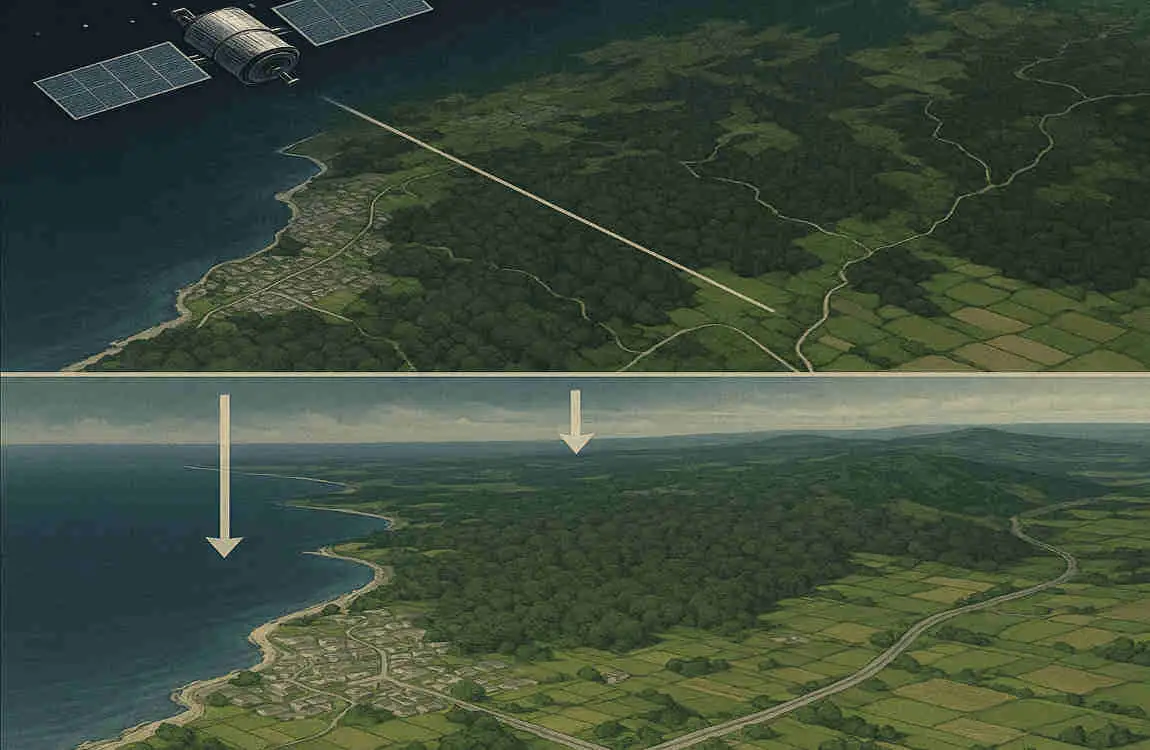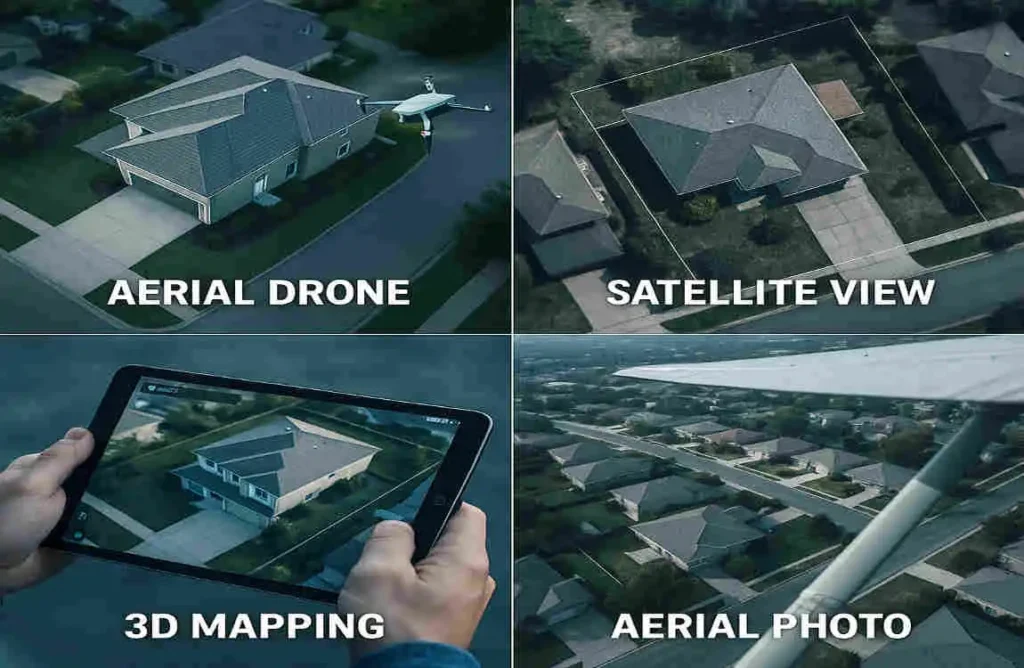Hey there! Have you ever wondered what your house looks like from way up in the sky? Maybe you’re curious about your neighbourhood, planning a home renovation, or want to see your property from a bird ’s-eye view for fun. Whatever your reason, the good news is that technology has made it incredibly easy to view your home from above. Thanks to satellite imagery and other cool tools, you can get a detailed overhead view of your place without ever leaving your couch.
Whether you’re a curious homeowner or someone with a specific need like property monitoring or security, I’ve got you covered. Please stay with me as we explore the simplest and most effective ways to view your home from space!
Understanding Satellite Imagery and Aerial Views

So, before we jump into the “how,” let’s get a clear picture of what satellite imagery is. Don’t worry—I’ll keep this simple! Satellite imagery refers to images of the Earth taken by satellites orbiting high above us. These satellites are like giant cameras in space, snapping detailed shots of everything from vast forests to tiny rooftops, including your house.
What Exactly Is Satellite Imagery?
Imagine a satellite as a photographer floating hundreds of miles above the planet. It captures images using special sensors and sends them back to Earth. These images enable us to view large areas at once, which is why they’re perfect for viewing properties, tracking weather, or even mapping cities. When you’re looking at a satellite view of my house, you’re seeing one of these space-captured snapshots.
Live, Near Real-Time, or Archived—What’s the Difference?
Now, let’s clear up a common confusion. Not all satellite images are “live.” Most of what you’ll find on popular platforms isn’t happening in real-time. Here’s the breakdown:
- Archived Images: These are older pictures, often dating back months or years, stored in databases. They’re the most common type you’ll see on free tools.
- Near Real-Time: Some platforms offer images taken within days or weeks of the event. These are fresher but still not “right now.”
- Live Images: True live views are rare and usually reserved for specialised (and expensive) services. Most of us won’t access these.
So, when you’re searching for ‘how can I view my house from satellite,’ keep in mind that you’re likely looking at a recent but not instantaneous photo.
Limitations You Should Know About
I hate to burst any bubbles, but satellite views aren’t perfect. First, the clarity (or resolution) might not always be sharp enough to see tiny details, such as your car in the driveway. Second, the images aren’t updated daily—sometimes they’re refreshed only once every few months or years, depending on the area. And finally, not every spot on Earth gets equal coverage. Rural areas might have less frequent updates compared to cities.
Busting Myths About Real-Time Views
Many people believe they can watch their house “live” from space, as seen in movies. Sorry to say, that’s mostly a myth for everyday users. Real-time satellite access is primarily for governments or large organisations with substantial budgets. For the rest of us, we’re working with archived or near-real-time data. But don’t worry—there are still excellent tools to get a great view of your home from space!
Popular Ways to View Your House from Satellite
Alright, let’s get to the fun part—seeing your house from above! Several platforms and tools make this possible, and I’ll walk you through the most popular ones. Whether you’re tech-savvy or just starting, these options are user-friendly and accessible. Let’s explore how you can find that perfect satellite view of my house.
You may also read (discover how an attic fan transforms home comfort).
Google Earth and Google Maps
If you’ve ever used Google Maps to find directions, you’re already halfway there. Google Earth and Google Maps are hands-down the most popular tools for viewing your house from above. They’re free, easy to use, and packed with features.
How to Use Google Earth and Google Maps
Getting started is a breeze. Open your browser or download the Google Earth app (it’s free!). Type your address into the search bar, hit enter, and—boom!—you’ll zoom right into an overhead view of your property. You can pinch to zoom in for details or switch to 3D mode for a cool angled perspective.
Here’s a quick step-by-step guide:
- Go to earth.google.com or open the Google Maps app.
- Enter your full address in the search box.
- Use the zoom tool to get closer—look for your roof or backyard!
- Toggle between “Satellite” view and “3D” mode for different angles.
How Current Are the Images?
One thing to note: the images on Google aren’t always the most recent. They’re typically updated every 1-3 years, depending on your location. So, if you’ve recently built a new deck, it might not show up yet. Still, it’s a fantastic starting point for most people asking, ‘How can I view my house from a satellite?’
Pros and Cons
On the plus side, Google Earth is free, widely available, and offers historical imagery (you can see older versions of your property!). The downside? Limited refresh rates and sometimes lower resolution in rural spots. But for casual viewing, it’s hard to beat.
Bing Maps – Bird’s Eye View
Not everyone knows this, but Bing Maps (Microsoft’s version of Google Maps) is another excellent tool for aerial views. It offers a unique “Bird’s Eye” feature that gives you an angled, almost drone-like perspective of your house.
How to Use Bing Maps
Head over to bing.com/maps, type in your address, and switch to “Aerial” mode. Then, click on “Bird’s Eye” if it’s available for your area. This view feels more immersive, like you’re hovering over your property at an angle.
Pros and Cons
Bing Maps is free and sometimes has different imagery than Google, so it’s worth checking both. The Bird’s Eye view is a standout feature. However, coverage isn’t as extensive as Google’s, and updates can be sporadic. Still, it’s a solid backup for finding a view of your home from space.
Specialised Platforms: Sentinel Hub and EO Browsers
If you’re looking for something a bit more advanced, platforms like Sentinel Hub are worth a peek. These tools utilise data from satellites like Sentinel-2, a component of the European space program, to provide detailed and often more recent images.
What Are Sentinel Hub and Sentinel-2?
Sentinel Hub is an online platform that allows you to access satellite data for free or with a paid subscription plan. Sentinel-2 satellites capture high-resolution images every few days, which is much fresher than Google’s updates. You can see things like vegetation health or recent changes around your property.
How to Use It
Visit sentinel-hub.com, sign up for a free account, and input your location (you might need coordinates for precision). You can filter by date or view multi-spectral images (advanced features like infrared for land analysis). It’s not as beginner-friendly as Google Earth, but it’s powerful for specific needs, such as farming or environmental monitoring.
Why Use It?
This is great if you’re into property assessment or need fresher data. The downside is the learning curve and the fact that it’s not always as visually polished as mainstream tools. Still, it’s a hidden gem for a detailed satellite view of my house.
TerraFly and Other Regional Providers
Ever heard of TerraFly? It’s a lesser-known platform focused on U.S. properties, offering aerial imagery with cool overlays, such as geographic data. There are also regional providers depending on where you live, often tied to local government or mapping projects.
How TerraFly Works
Head to terrafly.com, search your address, and explore aerial views with added data layers (think flood zones or property lines). It’s beneficial for U.S. residents seeking additional information about their country.
Other Options
You may also read (key insights on insurance coverage for house fires).
Some areas have niche platforms or government portals with satellite or aerial imagery. For example, county websites in the U.S. might offer free access to local maps. These are hit-or-miss but can provide unique details not found elsewhere.
Emerging Technologies for Near Real-Time Satellite Views

Okay, let’s talk about the cutting-edge stuff. If archived images from Google or Bing aren’t fresh enough for you, new commercial satellite services are stepping up. Companies like SkyFi are changing the game by offering near-real-time imagery, sometimes within 24 hours!
What Are Near Real-Time Services?
Unlike free platforms, these services let you “task” a satellite. That means you request a specific image of your location, and a satellite captures it on its next pass over the area. SkyFi, for instance, connects everyday users to satellite operators for custom shots.
How Does It Work?
You sign up on a platform like SkyFi, enter your location, and pay a fee (usually starting around $100-$200). Within a day or so, you get a high-resolution image of your house or land. It’s not cheap, but it’s as close as most of us will get to a live view of your home from space.
Why Use This?
This is perfect for urgent needs, such as checking property damage after a storm or monitoring a construction site. For personal use, it might be overkill, but for businesses or serious property management, it’s a game-changer.
How It Differs from Mainstream Tools
Unlike Google Earth, which is free and archived, these services are paid and tailored. You’re not browsing a database—you’re commissioning a fresh photo. Pretty cool, right? Have you ever needed an up-to-date image this badly? Let me know in the comments!
Using Drones and Aerial Photography as Alternatives
What if satellites aren’t your thing? Perhaps you would like a more hands-on, up-to-date perspective. That’s where drones come in. These small flying cameras can provide you with a customised overhead shot of your house whenever you want.
Why Choose Drones?
Drones are small, remote-controlled devices with cameras that can hover over your property. Unlike satellites, you control the angle, timing, and resolution. Want to see your new garden from 100 feet up? A drone can do that in minutes.
Legal and Safety Tips
Before you take off, check local laws. In many places, you can’t fly drones over private property without permission or near airports. Also, keep safety in mind—don’t fly in bad weather or near power lines. A quick online search for your area’s drone rules will save you headaches.
Drones vs. Satellites
Here’s a quick comparison to help you decide:
Feature Drones Satellites
Cost $200-$1,000 for a decent drone , Free (Google) to $200+ (custom)
Resolution: Very high, customizable. Varies, often lower in free tools
Update Frequency : Anytime you fly , Monthly/yearly (free), or on-demand
Control Full control over shots Limited to the platform’s data
Drones offer flexibility, but satellites are more suitable if you need a quick peek. Which sounds more like your style?
How to Choose the Best Method to View Your House from Above
With so many options, choosing the right way to view your house from above can feel challenging. Don’t worry—I’ll break it down for you. Let’s examine the key factors to consider so you can determine what works best.
What Matters Most?
Think about your needs. Here are a few things to weigh:
- Clarity: Do you need super-sharp images (drones or paid satellite services) or is “good enough” fine (Google Earth)?
- Freshness: Want the latest view? Near real-time services or drones are better than archived free tools.
- Cost: Free options, such as Bing Maps, are ideal for casual use, while custom imagery incurs additional costs.
- Ease: If tech isn’t your thing, stick to user-friendly platforms like Google Maps.
Casual vs. Professional Use
If you’re just curious, Google Earth or Bing Maps will do the trick. But if you’re managing a property, planning construction, or tracking changes, consider Sentinel Hub or a drone. Ask yourself: Why do you want this view? That’ll guide your choice.
Tips for Accuracy
Double-check your address or use coordinates (you can find them on Google Maps by right-clicking your location). A wrong input means you’re looking at someone else’s house! Also, test a few platforms—sometimes one has better coverage for your area.
Additional Tips and Tricks for Satellite Viewing
Before we wrap up, let’s review a few additional pointers to enhance your satellite viewing experience. These little hacks can save you time and help you maximise the benefits of these tools.
Boost Search Accuracy with Coordinates
Typing an address works most of the time, but coordinates are foolproof. On Google Maps, right-click your house, select “What’s here?” and copy the latitude and longitude. Paste those into any platform for a pinpoint view.
Check Historical Layers
Did you know Google Earth lets you see older images? Use the “Historical Imagery” tool (represented by a clock icon) to slide back in time. It’s fantastic for spotting changes, such as when the big tree in your yard was planted.
Mix with Street-Level Tools
Combine satellite views with street-level tools, such as Google Street View. See your house from above, then “walk” around it virtually. It’s like getting the complete picture without having to step outside.
You may also read (exploring the concept of rows in home real estate).

